By Duane Duchesne
Sports Editor
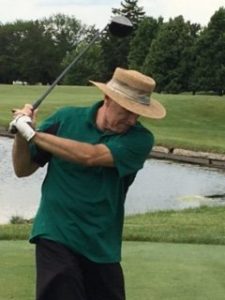 Notice the word ‘Dye’ in the title. and the way it is spelled, You may think that ‘Mr. Dimples’ is smarter than me. While the jury is still out on that one, the spelling thing here isn’t really evidence of that because it’s actually in reference to a well-known golf course designer by the name of Pete Dye. You see, this article is about playing the seven courses of the Pete Dye Golf Trail in Indiana.
Notice the word ‘Dye’ in the title. and the way it is spelled, You may think that ‘Mr. Dimples’ is smarter than me. While the jury is still out on that one, the spelling thing here isn’t really evidence of that because it’s actually in reference to a well-known golf course designer by the name of Pete Dye. You see, this article is about playing the seven courses of the Pete Dye Golf Trail in Indiana.
My journey began at the northernmost course and worked its way south which is how I’ll briefly describe the experience. But, before I do, I think that a warning is necessary. You see, if you like golf, you may come away from this reading with a wish that turns into a dream that turns into an itch that you just have to scratch. Now that you’ve been warned, let’s begin.
Tippecannoe Country Club
 We start at one of Pete Dye’s first projects, Tippecanoe Country Club in Monticello. The course borders Lake Shafer for much of the front nine before it heads inland on the back nine. Because of that, the front side is fairly level ground whereas the back nine fairways have some slight ups and downs. There are four sets of tees giving you the option that fits either your skill level or your dream score. And, while the water doesn’t really come into play on the course, there are quite a few bunkers and trees that do. It also has one of Pete’s signature holes, a double dogleg par 5. The impressive lake backdrop makes for a very relaxing round.
We start at one of Pete Dye’s first projects, Tippecanoe Country Club in Monticello. The course borders Lake Shafer for much of the front nine before it heads inland on the back nine. Because of that, the front side is fairly level ground whereas the back nine fairways have some slight ups and downs. There are four sets of tees giving you the option that fits either your skill level or your dream score. And, while the water doesn’t really come into play on the course, there are quite a few bunkers and trees that do. It also has one of Pete’s signature holes, a double dogleg par 5. The impressive lake backdrop makes for a very relaxing round.
Birck Boilermaker Golf Complex
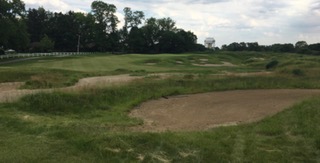 The next step in our journey takes us to West Lafayette, the home of Purdue University and the Birck Boilermaker Golf Complex which hosts 2 courses on the Pete Dye Golf Trail.The Ackerman-Allen Course is a parkland-style championship golf course with rolling hills and tree-lined fairways. The layout provides a challenge for golfers of all abilities by providing five sets of tees. It features large bent-grass greens, fairways, and tees. Not only does it have 2 of Pete Dye’s signature double dogleg par 5s, but the par 3 seventeenth also has a bunker that runs from tee to green on the left side, which is another of Pete’s autographs.
The next step in our journey takes us to West Lafayette, the home of Purdue University and the Birck Boilermaker Golf Complex which hosts 2 courses on the Pete Dye Golf Trail.The Ackerman-Allen Course is a parkland-style championship golf course with rolling hills and tree-lined fairways. The layout provides a challenge for golfers of all abilities by providing five sets of tees. It features large bent-grass greens, fairways, and tees. Not only does it have 2 of Pete Dye’s signature double dogleg par 5s, but the par 3 seventeenth also has a bunker that runs from tee to green on the left side, which is another of Pete’s autographs.
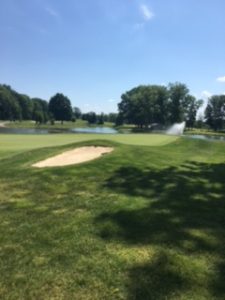 The Kampen Course is a links-style championship golf course again featuring large bent-grass greens, fairways and tees. Kampen also offers five sets of tees with the championship tees playing at over 7,400 yards. It also has 2 double dogleg par 5s and a tee to green bunker except for this time it’s on a par 4. Kampen is ranked as one of the most difficult golf courses in Indiana. With huge sand bunkers, native grasslands, ponds, and even a bog that can easily come into play, you can start to see why some of Pete Dye’s layouts are referred to as ‘Dyeabolical.’
The Kampen Course is a links-style championship golf course again featuring large bent-grass greens, fairways and tees. Kampen also offers five sets of tees with the championship tees playing at over 7,400 yards. It also has 2 double dogleg par 5s and a tee to green bunker except for this time it’s on a par 4. Kampen is ranked as one of the most difficult golf courses in Indiana. With huge sand bunkers, native grasslands, ponds, and even a bog that can easily come into play, you can start to see why some of Pete Dye’s layouts are referred to as ‘Dyeabolical.’
From there we go to Indianapolis where the next three Pete Dye designs are located. Despite each course having Pete Dye’s trademarks (double dogleg par 5s, undulating greens, and an abundance of bunkers), each course also has its own distinctively unique feel.
Fort Golf Course
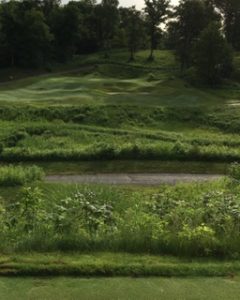 The Fort Golf Course is on what used to be a key U.S. Army post, Fort Benjamin Harrison, which closed in 1996. It is considered one of Indiana’s finest public courses and is ranked annually by national golf publications as one of the top ten in the state. The Fort, like the previous course that we looked at, also has five sets of tees ranging from just over 5,000 yards to over 7,100 yards from the backtees.
The Fort Golf Course is on what used to be a key U.S. Army post, Fort Benjamin Harrison, which closed in 1996. It is considered one of Indiana’s finest public courses and is ranked annually by national golf publications as one of the top ten in the state. The Fort, like the previous course that we looked at, also has five sets of tees ranging from just over 5,000 yards to over 7,100 yards from the backtees.
Now, if the bunkers weren’t there to remind you of the trouble you could get into, the tree-lined fairways and rolling hills would be some of the most relaxing and beautiful scenery you’ll ever see. But the bunkers are there! And in great numbers! So much so that the feeling can quickly go from a peaceful appreciation into a ‘Dyeabolical’ disaster in a split second. And, if the sand wasn’t enough, this 1,700-acre complex is unusually hilly for central Indiana. This means that, if you miss the fairway, and I know this from personal experience, you just might have a sidehill lie so severe that Mr. Dimples is looking at you eye to eye.
Also, being on the green is no more relaxing than being on the tee. Did I mention unusually hilly terrain? This means that there are very few straight putts ten feet or further from the hole. Oh, it may look straight, but it may weave to the right and then the left like a fickle politician before it reaches its destination. But, regardless of the challenges, The Fort is an outstanding golf experience for golfers of all skill levels.
Maple Creek Golf and Country Club
 Our next ‘Dye cast’ encounter is on the northeast side of Indianapolis at the Maple Creek Golf and Country Club. Here we step back 50 years and see how one of the game’s greatest architects got his start because this course has the distinct honor of being Pete Dye’s first 18-hole design. Created in partnership with his wife, Alice, Maple Creek features narrow fairways lined with mature trees and natural long grass areas. It also has, and this is no surprise, multiple bunkers along with a troublesome creek that winds its way through the front nine. Of particular interest is the par 5 thirteenth hole; it has a green that is, no joke, 52 yards long. It is literally possible to be on the green and pull out your driver. The course has four sets of tees to challenge players of all skill levels.
Our next ‘Dye cast’ encounter is on the northeast side of Indianapolis at the Maple Creek Golf and Country Club. Here we step back 50 years and see how one of the game’s greatest architects got his start because this course has the distinct honor of being Pete Dye’s first 18-hole design. Created in partnership with his wife, Alice, Maple Creek features narrow fairways lined with mature trees and natural long grass areas. It also has, and this is no surprise, multiple bunkers along with a troublesome creek that winds its way through the front nine. Of particular interest is the par 5 thirteenth hole; it has a green that is, no joke, 52 yards long. It is literally possible to be on the green and pull out your driver. The course has four sets of tees to challenge players of all skill levels.
Brickyard Crossing
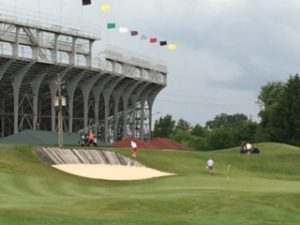 Saying that our next golf experience is unique is an understatement. Only Indianapolis could combine the very audible excitement of auto racing with the peaceful, quiet beauty of a championship golf course like Brickyard Crossing. And, when I say combine, I actually mean intertwine. This Pete Dye designed course includes a four-hole stretch on the inside of the track of the Indianapolis Motor Speedway. So, in addition to the ‘Dyeabolic’ challenges of undulating greens, double dogleg par 5s, and an abundance of bunkers, on the holes on the inside of the track you also have to contend with the intense noise of unmuffled racing engines and screeching tires from the race cars and motorcycles as they do their trial runs. But, despite the noise, exhaust, and the smell of burning rubber, it’s quite a thrilling course to play.
Saying that our next golf experience is unique is an understatement. Only Indianapolis could combine the very audible excitement of auto racing with the peaceful, quiet beauty of a championship golf course like Brickyard Crossing. And, when I say combine, I actually mean intertwine. This Pete Dye designed course includes a four-hole stretch on the inside of the track of the Indianapolis Motor Speedway. So, in addition to the ‘Dyeabolic’ challenges of undulating greens, double dogleg par 5s, and an abundance of bunkers, on the holes on the inside of the track you also have to contend with the intense noise of unmuffled racing engines and screeching tires from the race cars and motorcycles as they do their trial runs. But, despite the noise, exhaust, and the smell of burning rubber, it’s quite a thrilling course to play.
French Lick
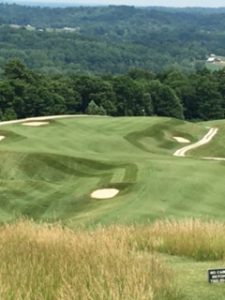 We conclude our brief but adventurous exploration of the Pete Dye Golf Trail in Indiana by traveling south to the French Lick Resort. Originally conceived as a sketch on a napkin at a nearby restaurant, the Pete Dye Course Golf Course at French Lick has received accolades from many prestigious entities including Golfweek and Golf Digest.
We conclude our brief but adventurous exploration of the Pete Dye Golf Trail in Indiana by traveling south to the French Lick Resort. Originally conceived as a sketch on a napkin at a nearby restaurant, the Pete Dye Course Golf Course at French Lick has received accolades from many prestigious entities including Golfweek and Golf Digest.
While the course stretches to over 8,100 yards from the back tees (you may need your passport to play from there), it features six other sets of tees making it playable by golfers of every skill level. And skill is the operative word here.
I’ve got good news and bad news. The good news is that the course is fairly open; there aren’t many trees for Mr. Dimples to rest in the shade of or to hide behind. And there are no double dogleg par 5s to try to steer through. What a relief, right?
Wrong! You see, this course is built on the hilltop of the highest point in Indiana (I think you can actually see Kentucky from there). Because of this, not only are the greens undulating, the fairways are too. And it’s intense; up, down, right, left; if you were navigating water instead of land, you’d need something for sea sickness. And these wave-tossed fairways are narrow; so narrow that I saw the right rough and the left rough holding hands on one hole (I may be exaggerating). And, if that weren’t enough, there are these sinister-looking sand traps called “volcano” bunkers. You see, on some of the more elevated hills, they’ve chopped off the top, dug a deep hole, and filled it with sand. But, unlike a true volcano, it doesn’t erupt. You do with an “Oh no. What do I do now?”
But I don’t say all of these things to discourage you. In fact, it’s quite the opposite. All of these things make it the most exciting and wondrous golfing adventure I’ve ever experienced. It’s something that I will never forget and always treasure.
Well, that about sums up a very brief description of my journey on The Pete Dye Golf Trail of Indiana. I hope this small taste of some of golf’s greatest delicacies has sparked a wish or a dream in your golfer’s heart. I assure you, just telling you about it has re-awakened that itch that I may have to scratch again.

 Extended Weekend Getaways
Extended Weekend Getaways 


